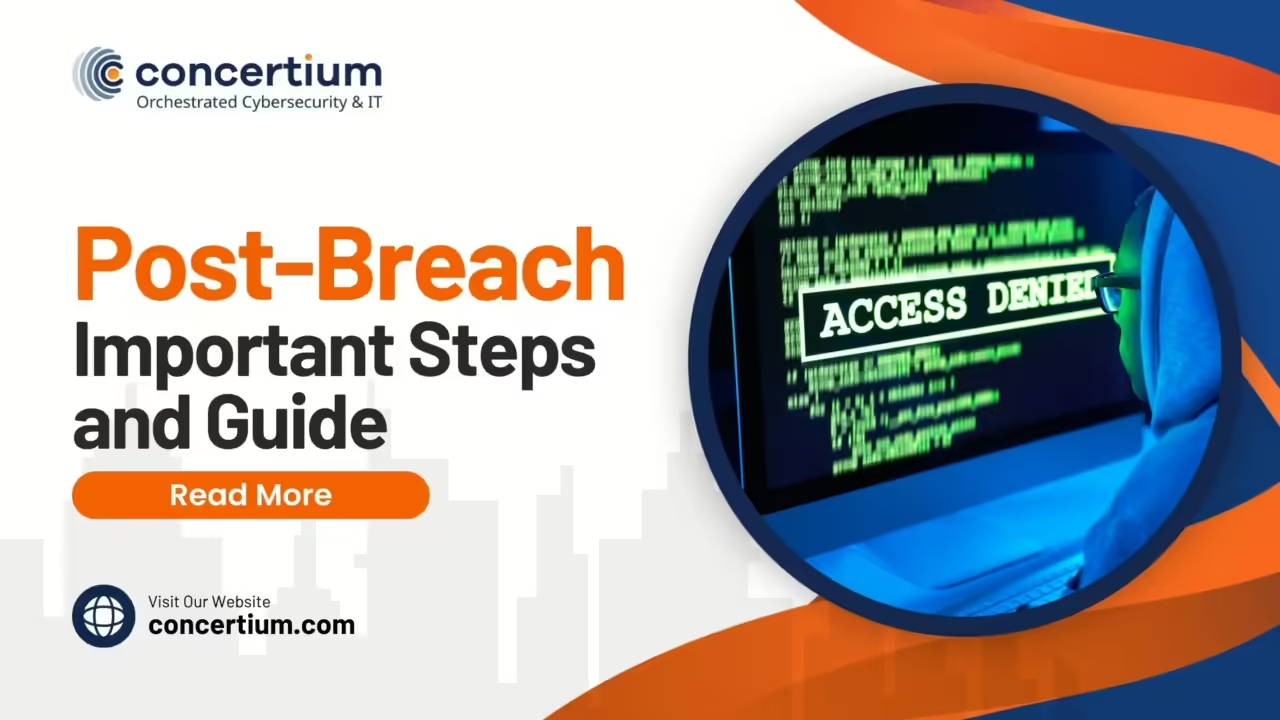A Post-Breach Guide
Handling a security breach effectively is paramount. When an incident occurs, timely and efficient action can significantly mitigate damage. Above all, a well-structured response can prevent future breaches and protect personal data. Therefore, understanding the steps to take post-breach is crucial.
This guide aims to provide a comprehensive roadmap for post-breach actions. By following these steps, you can ensure a robust incident response, enhancing your data security and overall cybersecurity. In addition, this guide will cover immediate actions, investigation procedures, remediation strategies, and long-term preventative measures.
Immediate Actions to Take Post-Breach
Assess the Situation
Firstly, it’s essential to identify the nature and scope of the data breach. What systems and data were affected? In other words, you need to understand the extent of the damage. Quickly gather information on what happened, how it happened, and which areas are impacted. This initial assessment will guide your next steps.
Determine affected systems and data. Create an inventory of compromised systems and data. Above all, focus on critical assets. This step will help prioritize containment and remediation efforts. By understanding the full scope, you can ensure a more effective response and mitigate further damage.
Contain the Breach
Once you understand the breach, it’s time to contain it. Isolate compromised systems to prevent the breach from spreading. Disconnect affected devices from the network. This immediate action can stop the attacker from causing more harm.
Next, implement temporary containment measures. For instance, change passwords and revoke compromised credentials. Limit access to affected areas until the situation is under control. In addition, consider implementing network segmentation to isolate critical systems.
After that, review and adjust your containment strategies as more information becomes available. Continuously monitor for unusual activity. Similarly, use tools like firewalls and intrusion detection systems to enhance containment efforts. By swiftly isolating compromised systems, you can significantly reduce the potential damage.
Notify Key Stakeholders
Inform internal teams and management as soon as possible. Transparency is vital in a post-breach situation. Keep everyone informed about the status and steps being taken. This helps in coordinated efforts across the organization.
Notify external partners and customers who might be affected. Clear and honest communication builds trust. Provide them with relevant information about the breach and steps they should take to protect themselves. In addition, offer support and remediation services.
Moreover, ensure you meet legal and regulatory notifications. Different jurisdictions have specific requirements for breach notifications. For example, the GDPR mandates that breaches involving personal data must be reported within 72 hours. Compliance with these regulations is crucial to avoid further penalties and maintain credibility.
Investigating the Breach
Conduct a Thorough Investigation
Start by forming an investigation team. This team should include cybersecurity experts, IT staff, and legal advisors. Their goal is to collect and preserve evidence. Accurate data collection is vital for understanding the breach and taking corrective actions.
Collect and preserve evidence. Secure logs, network traffic data, and any other relevant information. This will help in identifying the attack vector and understanding how the breach occurred. Moreover, this evidence is crucial for reporting and future prevention.
In addition, maintain a detailed record of all investigation activities. This documentation will be useful for internal review and external reporting. By conducting a thorough investigation, you can uncover the root cause of the breach and take appropriate actions to prevent recurrence.
Determine the Attack Vector
Analyze how the breach occurred. Was it due to a vulnerability in the system? Or was it a result of phishing or social engineering? Identifying the attack vector is crucial to fixing the root cause.
Identify vulnerabilities exploited. Once you know how the attacker gained access, you can start closing those gaps. This might involve patching software, updating security protocols, or improving employee awareness. In other words, understanding the attack vector helps in fortifying your defenses against future breaches.
Evaluate the Damage
Assess data loss and integrity. Determine what data was accessed, modified, or exfiltrated. This step helps in understanding the impact on your organization and its stakeholders.
Evaluate operational impact. How did the breach affect your operations? Were there disruptions to services or productivity? By evaluating the damage, you can prioritize recovery efforts and plan for remediation. In addition, this assessment will inform your communication with stakeholders and regulatory bodies.
Remediation and Recovery
Fix Vulnerabilities
After containing the breach, it’s crucial to address the vulnerabilities that were exploited. Patch exploited vulnerabilities immediately. This involves applying security patches to software, updating firmware, and fixing any configuration issues. Above all, ensure that your systems are no longer susceptible to the same type of breach.
Next, enhance security measures to prevent future incidents. For instance, implement multi-factor authentication, improve encryption standards, and review access controls. In addition, conduct a thorough security audit to identify and rectify any other potential weaknesses. By taking these steps, you can bolster your defenses against future attacks.
It’s also important to consider deploying advanced security tools. These tools can include intrusion detection systems, firewalls, and endpoint protection. Moreover, regularly update these tools to keep up with evolving threats. By proactively addressing vulnerabilities, you reduce the risk of recurrence and enhance your overall data security.
Restore Affected Systems
Once vulnerabilities are fixed, focus on restoring affected systems. Start by recovering data from backups. Ensure that backups are recent and uncorrupted. If you don’t have reliable backups, this step becomes more challenging but is still essential.
Ensure system integrity before going live. This means thoroughly testing restored systems to confirm they are free from malware and other security issues. In other words, don’t rush the process. Validate that your systems operate correctly and securely.
After that, gradually bring systems back online. Monitor them closely for any signs of trouble. In addition, communicate with your IT team to ensure they are aware of the restoration process and can provide support if needed. By meticulously restoring systems, you can return to normal operations with confidence.
Communicate with Affected Parties
Provide updates and next steps to customers as soon as possible. Transparency is key in maintaining trust. Inform them about what happened, how it affects them, and what steps they should take to protect themselves. For instance, if social security numbers or other sensitive data were compromised, advise on identity theft protection measures.
In addition, offer support and remediation services. This might include credit monitoring services, identity theft protection, or dedicated customer support lines. Show your commitment to rectifying the situation and safeguarding their interests.
Moreover, keep the lines of communication open. Regularly update affected individuals on the progress of remediation efforts and any new developments. By being proactive and supportive, you can help mitigate the impact of the breach and rebuild trust with your customers.
Post-Breach Analysis and Reporting
Document Findings
After handling the immediate aftermath, it’s time to document findings. Create detailed breach reports that outline what happened, how it was discovered, and the steps taken to address it. Include timelines, involved parties, and the nature of the breach.
Record all actions taken during the incident response. This includes initial assessments, containment measures, remediation steps, and communication efforts. Thorough documentation is crucial for internal reviews and potential external audits. It also serves as a reference for improving future incident response plans.
In addition, ensure that your documentation is clear and comprehensive. Use it to inform your team and stakeholders about the breach and the measures taken to mitigate it. Detailed records help in understanding the breach and preventing similar incidents in the future.
Review Response Effectiveness
Analyze the incident response process. Was the breach contained quickly? Did communication flow smoothly? Identify what worked well and where there were gaps.
Identify areas for improvement. This could involve updating your incident response plan, improving communication channels, or investing in better security tools. Use the lessons learned from the breach to enhance your overall security posture.
Moreover, involve your team in the review process. Gather feedback from all involved parties to gain a comprehensive understanding of the response effectiveness. By continuously refining your approach, you can manage future incidents more effectively.
Regulatory Compliance and Reporting
Ensure compliance with legal requirements. Different regions have specific breach notification laws. For example, if the breach involves personal data, you might need to notify key governing bodies.
Report to relevant authorities as required. This helps maintain transparency and avoids potential legal repercussions. Make sure your reports are accurate and timely.
In addition, stay informed about evolving regulations. Compliance isn’t a one-time task; it’s an ongoing responsibility. By keeping up with legal requirements, you ensure that your business remains in good standing and avoids costly fines.
Long-Term Strategies to Prevent Future Breaches
Implement Strong Security Policies
Develop and enforce comprehensive security policies. These policies should cover everything from password management to data encryption. Ensure that they are clear, accessible, and regularly updated.
Regularly update security protocols to adapt to new threats. For instance, incorporate the latest best practices for cybersecurity. This might include mandatory multi-factor authentication, regular software updates, and strict access controls.
In addition, involve your employees in the policy development process. This ensures that policies are practical and take into account the unique needs of your organization. By having strong, enforced security policies, you create a robust defense against potential breaches.
Employee Training and Awareness
Conduct regular security training sessions. Educate your employees about common threats, such as phishing and social engineering. Use real-world examples to make the training relatable and engaging.
Promote a culture of security awareness. Encourage employees to report suspicious activity and to follow security protocols diligently. In other words, make security everyone’s responsibility.
Furthermore, provide ongoing education. Cyber threats are constantly evolving, and so should your training programs. Regularly update your training materials and sessions to reflect the latest threats and security measures. By fostering a security-conscious culture, you can significantly reduce the risk of human error leading to breaches.
Continuous Monitoring and Improvement
Implement ongoing security monitoring. Use tools that provide real-time alerts for suspicious activity. This allows for quick response to potential threats before they escalate.
Regularly review and update security measures. Conduct periodic security audits to identify and address vulnerabilities. In addition, stay informed about new threats and update your defenses accordingly.
Continuous improvement is key. After each audit or security incident, reassess your security posture and make necessary adjustments. By maintaining a proactive approach, you can stay ahead of potential threats and ensure your data remains secure.
Conclusion
In conclusion, handling a security breach effectively involves a structured response. Assessing the situation, containing the breach, and notifying key stakeholders are critical first steps. Investigating the breach and fixing vulnerabilities prevent future incidents. Communicating with affected parties and documenting findings are essential for transparency and improvement.
Above all, proactive measures like strong security policies and continuous monitoring can significantly reduce your risk. By following this guide, you can manage security incidents more effectively and safeguard your organization’s data.
Stay vigilant, keep your security measures updated, and always be prepared for potential threats. Remember, a proactive approach is your best defense against the ever-evolving landscape of cyber threats.




